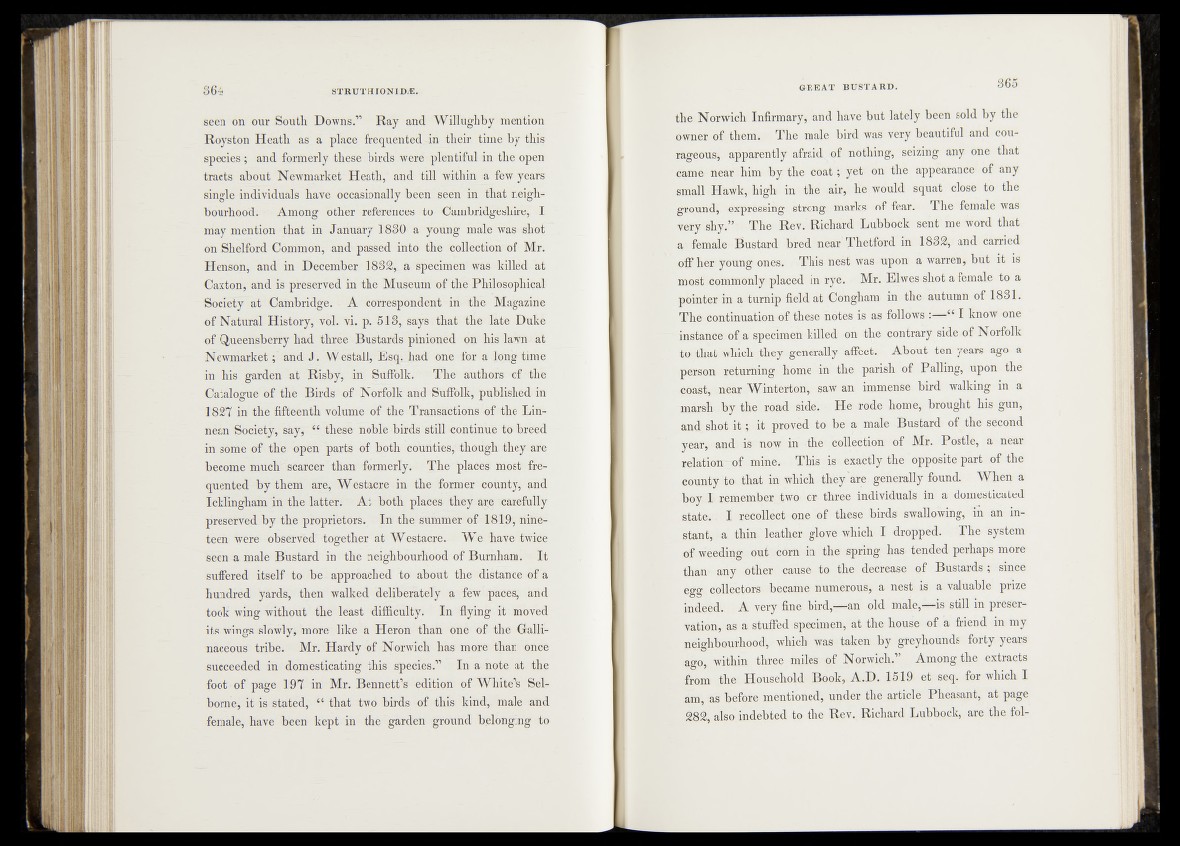
seen on our South Downs.'” Ray and Willughby mention
Royston Heath as a place frequented ,4n- their time|hy+th.is
species; and formerly these birds word plentifel^in the open
tracts about Me#jaiarhet; Heath,' and tillwithm years
single individuals - hafe occasionally been%eeh in that neighbourhood*
Among* dtheri^eidfences to GanibMdgeShirej I
may mention that in January'1830 a fy©ung male was-sbotT
on Shelford Common;- and passed#iato the 'oollectfon'of Mr.
Henson, and in December; 1 a-fsptecMerf was'' killed- at
Gaxton, and is preserved in "the Museum of the'Philosophical
"Eocieiy^at Cambridge. ^ A ^» e sp o n d en t id the Magazine
of Natural History,im>.R''vi. p. ®tf8, says, that the.late^DtiM
of'Queensberry had three -Busiards’-piffioned on his lawn-at
Newmarket ;£ and J . Westail;; E sq; had’ one#^sa^gng$ime
in his girded at Risby, -in Suffolk«''' ' The' authors of the
Catalogue’of the Birds" oh Norfolk and' ShhoffiffpnbfeMd*in
18^f in the fifteenth volume of the ^rangaetionsuof-the Lin-
nean Society, say," *_c these noble birds'still'eontin^t^lbihed
iff: shift© of-the ©peh parts of both thiH^ghf4fiSy are
become much1 scarcer than formerly^ The places nifiM'ifre-
quffliled^by them are, Westactg.in the former&eots40^|.^&0..
Icklingham 'ift the l a t t e r ? A h both places they 3>ge 'Carefully
preserved.by the proprietors:,- In the summer'of ]?8rl>9; nineteen
were - observedT -together at Westacre. We ,ha’f'C$ twice
seena male Bustard in the neighbourhocfdrof Burnham* ^ i t
suffered itself to heiapproached to about the distance of a
hundred yards, then walked deliberately avfewUpace^; and
took wing without the least difficulty. In ^flying it moved
its wings slowly, more. like a Heron than one of the Gallinaceous
tribe. Mr. Hardy ;©f'Norwich has more; than once
succeeded in domesticating this species.” In a-mote at the
foot • of page 197 in Mr. Bennett’s edition of White’s Sel-
bomey'it is stated, ‘‘ that two birds of this kind, male and
female, have been kept in the garden ground belonging to
the Norwich Infirmary, and have but lately been sold by the
owner of them* -' The mat©* bird was very beautiful and courageous,
apparently afraid of* nothing, seizing any one that
came-near him by tfe • coat; yet on the appearance of any
small Hawk, high* |||t h e air, he would’^ squat close to the
ground, -expressing- strong marks of fear. The female was
, yea?y;shfi” ' The Rev.'Richard Lubbock sent me word that
a female Bustard^lbred near’ ’Jhetford in 1832, and carried
off her! young!onds^ ThlllJhe'sf was- upon' a warren, but it is
moitf comnronlyjplaced im-pylh Mr. Ejwes shot a female to a
pbint^^in ^tUriipt^fleld- at Cftn-g-haiff in-the autumn of-1831.
The|^®^hua'tiom©f''th#eS^^’is as’follows I know one
instance of a specimen kille#©n tip© contrary side .of-Norfolk
toUthab^hLch* theyfgenerally affect. About ten years ago a
person ’§@turiiing hom'd in the parish of Pailing, upon the
coastigSnear Win-terfofey. saw an immense bird walking in a
marsh by the. road* side. He rode honfe, brought his gun,
and shbtusfc,; it provedi t4b^? a male Bustard of the second
year, a n d ^ l now in «the* collections Fof Mr. PoStie, a near
relatioir-ofd-mine^ This *is' exactly the ' opposite part of the
county itp* that in which they'are generally fo u n d ^ When a
bayH remember two or three individuals in a domesticated
stated I recollect one of these birds swallowing, -in an in-
stan^fa th in leather- glove which I dropped. The -system
of weeding out .com in the spring has tended perhaps more
than' any other ca&$8|to the'decrease of Bustards; since
e g g coUectors-ibecame numCrOusy a nest is a valuable prize
indeed. A very fine bird,-—an old male,—-is still in preservation,
as a stuffed specimen, at the house of a friend in my
neighbourhood, which- was taken by greyhounds forty years
ago, within three miles: of Norwich.” Among the extracts
from the Household Book, A.D. 1519 et seq. for which I
am, as before mentioned, under the article Pheasant, at page
282, also indebted to the Rev. Richard Lubbock, are the fob